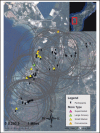Para I Famagu'on-Ta: Fruit and Vegetable Intake, Food Store Environment, and Childhood Overweight/Obesity in the Children's Healthy Living Program on Guam
- PMID: 28808612
- PMCID: PMC5551277
Para I Famagu'on-Ta: Fruit and Vegetable Intake, Food Store Environment, and Childhood Overweight/Obesity in the Children's Healthy Living Program on Guam
Abstract
This cross-sectional study examined the: (1) association between food store environment (FSE), fruit and vegetable (FV) availability and access, and prevalence of early childhood overweight/obesity (COWOB); and (2) influence of young child actual FV intake on the relationship between the FSE and early COWOB prevalence. Anthropometric and socio-demographic data of children (2 to 8 years; N=466) in baseline communities on Guam participating in the Children's Healthy Living (CHL) Program community trial were included. CDC year 2000 growth charts were used to calculate BMI z-scores and categories. FSE factors (fresh FV scores, store type) were assessed using the CX3 Food Availability and Marketing Survey amended for CHL. ArcGIS maps were constructed with geographic coordinates of participant residences and food stores to calculate food store scores within 1 mile of participant's residences. A sub-sample of participants (n = 355) had Food and Activity Log data to calculate FV and energy intakes. Bivariate correlations and logistic regression evaluated associations. Of 111 stores surveyed, 73% were small markets, 16% were convenience stores, and 11% were large grocery/supermarkets. Supermarkets/large grocery stores averaged the highest FV scores. Most participants did not meet FV intake recommendations while nearly half exceeded energy intake recommendations. Living near a small market was negatively correlated with BMI z-score (r = - 0.129, P < .05) while living near a convenience store was positively correlated with BMI z-score (r = 0.092, P < .05). Logistic regression analysis yielded non-significant associations. The high density of small markets may be an opportunity for FSE intervention but further investigation of Guam's FSE influence on health is needed.
Keywords: Guam; childhood obesity; dietary intake; food store; nutrition environment.
Conflict of interest statement
The authors declare that there is no conflict of interest.
Figures
Similar articles
-
Evidence That Changes in Community Food Environments Lead to Changes in Children's Weight: Results from a Longitudinal Prospective Cohort Study.J Acad Nutr Diet. 2021 Mar;121(3):419-434.e9. doi: 10.1016/j.jand.2020.10.016. Epub 2020 Dec 10. J Acad Nutr Diet. 2021. PMID: 33309589 Free PMC article.
-
Prevalence and Predictors of Overweight and Obesity among Young Children in the Children's Healthy Living Study on Guam.Nutrients. 2020 Aug 20;12(9):2527. doi: 10.3390/nu12092527. Nutrients. 2020. PMID: 32825433 Free PMC article.
-
Neighborhood food store availability in relation to food intake in young Japanese women.Nutrition. 2009 Jun;25(6):640-6. doi: 10.1016/j.nut.2009.01.002. Epub 2009 Feb 28. Nutrition. 2009. PMID: 19251396
-
Grocery store access and childhood obesity: A systematic review and meta-analysis.Obes Rev. 2021 Feb;22 Suppl 1(Suppl 1):e12945. doi: 10.1111/obr.12945. Epub 2019 Oct 25. Obes Rev. 2021. PMID: 31650697 Free PMC article.
-
[Simple obesity in children. A study on the role of nutritional factors].Med Wieku Rozwoj. 2006 Jan-Mar;10(1):3-191. Med Wieku Rozwoj. 2006. PMID: 16733288 Review. Polish.
Cited by
-
The Retail Food Sector and Indigenous Peoples in High-Income Countries: A Systematic Scoping Review.Int J Environ Res Public Health. 2020 Nov 27;17(23):8818. doi: 10.3390/ijerph17238818. Int J Environ Res Public Health. 2020. PMID: 33261090 Free PMC article.
-
Food environments in the Pacific region and efforts to improve them: a scoping review.Public Health Nutr. 2024 Nov 26;28(1):e5. doi: 10.1017/S1368980024002350. Public Health Nutr. 2024. PMID: 39587426 Free PMC article.
-
Prevalence, causes and contexts of childhood overweight and obesity in the Pacific region: a scoping review.Open Res Eur. 2023 Nov 20;3:52. doi: 10.12688/openreseurope.15361.2. eCollection 2023. Open Res Eur. 2023. PMID: 38031554 Free PMC article.
-
Neighborhood supermarket access and childhood obesity: A systematic review.Obes Rev. 2021 Feb;22 Suppl 1(Suppl 1):e12937. doi: 10.1111/obr.12937. Epub 2019 Sep 3. Obes Rev. 2021. PMID: 31482658 Free PMC article.
-
The Association of Cardiometabolic Risk Factors in Parent-Child Dyads in Guam: Pacific Islands Cohort on Cardiometabolic Health Study.Int J Environ Res Public Health. 2025 Apr 14;22(4):611. doi: 10.3390/ijerph22040611. Int J Environ Res Public Health. 2025. PMID: 40283835 Free PMC article.
References
-
- WHO, author. Global strategy on diet, physical activity and health: childhood overweight and obesity. 2014
-
- Novotny R, Fialkowski M, Li F, et al. Systematic Review of Prevalence of Young Child Overweight and Obesity in the United States-Affiliated Pacific Region Compared With the 48 Contiguous States: The Children's Healthy Living Program. Am J Public Health. 2015;105(1):e22–e35. doi: 10.2105/AJPH.2014.302283. - DOI - PMC - PubMed
-
- Sallis JF, Glanz K. The role of built environments in physical activity, eating, and obesity in childhood. The future of children. 2006. Available at: http://muse.jhu.edu/journals/foc/summary/v016/16.1sallis.html. - PubMed
MeSH terms
LinkOut - more resources
Full Text Sources
Medical


